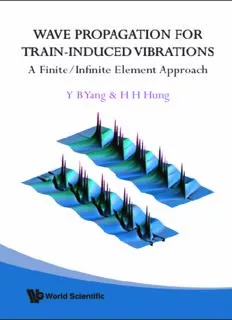Table Of ContentWAVE PROPAGATION FOR
TRAIN-INDUCED VIBRATIONS
A Finite/Infinite Element Approach
TThhiiss ppaaggee iinntteennttiioonnaallllyy lleefftt bbllaannkk
WAVE PROPAGATION FOR
TRAIN-INDUCED VIBRATIONS
A Finite/Infinite Element Approach
Y B Yang
National Taiwan University, Taiwan
H H Hung
National Center for Research on Earthquake Engineering, Taiwan
World Scientific
NEW JERSEY • LONDON • SINGAPORE • BEIJING • SHANGHAI • HONG KONG • TAIPEI • CHENNAI
A-PDF Merger DEMO : Purchase from www.A-PDF.com to remove the watermark
Published by
World Scientific Publishing Co. Pte. Ltd.
5 Toh Tuck Link, Singapore 596224
USA office: 27 Warren Street, Suite 401-402, Hackensack, NJ 07601
UK office: 57 Shelton Street, Covent Garden, London WC2H 9HE
British Library Cataloguing-in-Publication Data
A catalogue record for this book is available from the British Library.
WAVE PROPAGATION FOR TRAIN-INDUCED VIBRATIONS
A Finite/Infinite Element Approach
Copyright © 2009 by World Scientific Publishing Co. Pte. Ltd.
All rights reserved. This book, or parts thereof, may not be reproduced in any form or by any means,
electronic or mechanical, including photocopying, recording or any information storage and retrieval
system now known or to be invented, without written permission from the Publisher.
For photocopying of material in this volume, please pay a copying fee through the Copyright
Clearance Center, Inc., 222 Rosewood Drive, Danvers, MA 01923, USA. In this case permission to
photocopy is not required from the publisher.
ISBN-13 978-981-283-582-6
ISBN-10 981-283-582-2
Printed in Singapore.
YHwa - Wave Propagation.pmd 1 2/26/2009, 9:42 AM
To our families
TThhiiss ppaaggee iinntteennttiioonnaallllyy lleefftt bbllaannkk
Foreword
In the four years since the senior author published his first book on
Vehicle-Bridge Interaction Dynamics (World Scientific 2004), interest in
this subject has spread over the whole globe, especially in Taiwan and
Mainland China on the planning, design and construction of high speed
railways. Since the completion of the high speed railways in Taiwan
in 2007, our theoretical and our practical knowledge of the subject
have expanded rapidly. The senior author with his many students has
contributed fruitful ideas and computational techniques to advance the
field.
The first book was focused on super structure vibration involving
vehicle-bridge resonance caused by the moving trains at high speeds.
This book deals exclusively with the theoretical principles and numerical
techniques on infra-structural vibrations caused by the wave propagation
of the ground and the vibration of buildings located along side the
railways.
Here, as in every other field of engineering, the first theoretical
principles are developed on the basis of a highly idealized condition with
radical simplification of material model for soils and structures. Hence
it is advisable and realistic that the authors began their new book
exclusively with the theoretical treatment of the problem separated from
practical applications. The magnitude of the difference between the
performances predicted on the basis of the theory can only be ascertained
by field experience. Under certain conditions and restrictions, some of
the theories have stood the test of experience which is applicable to the
approximate solution of practical problems.
vii
viii Wave Propagation for Train-Induced Vibrations
It is a great pleasure to commend to you, the reader, this remarkably
comprehensive book combining fundamental theory and numerical
techniques on wave propagation and train-induced vibrations. The
authors have brought together in a unified manner for the first time so
much of what until now was available in journal papers authored mostly
by the senior author and his former students which are known only to a
few in the field. Students, researchers and practitioner will all benefit
much from reading this book and having it for reference in the years to
come.
W. F. Chen
Honolulu, Hawaii
March 2008
Preface
The commercial operation of the first high-speed train, i.e., the bullet
train, in 1964 with a speed of 210 km/hr in the Japanese railways
connecting Tokyo and Osaka marked the advent of a new era for railway
engineering. Since then, high-speed trains with speeds over 200 km/hr
have emerged as an effective tool for intercity transportation in several
countries in Europe and Asia, including Japan, Germany, France,
Italy, Spain, United Kingdom, Korea, Taiwan, China, etc. The trend of
constructing new high-speed railways or upgrading existing railways to
raise the train speeds is expected to remain upward for some years.
In order to provide unobstructed right of way, especially in densely
populated areas, high-speed railway tracks are often carried by multi-unit
elevated bridges. By doing so, the railway tracks can be maintained in an
exclusive way and alleviated significantly from the settlement caused by
the adjacent sinking ground. This has been the philosophy behind the
construction of high-speed railways in Taiwan. Of the total length of
345 km high-speed railways in Taiwan, it is amazing to see that
73 percent of the railway track runs through the multi-unit elevated
bridges, 18 percent runs through the tunnels, and only 9 percent runs
through the traditional embankments.
The vibrations caused by moving trains over multi-unit elevated
bridges may be classified into two categories related to the super- and
infra-structural vibrations. As far as the super-structural vibrations are
concerned, it is essential that the vibrations of the bridge and vehicles
under the moving loads be kept within the design tolerance limits, as
they both relate to the safety and maneuverability of the moving trains at
ix
Description:For buildings and factories located near railway or subway lines, the vibrations caused by the moving trains, especially at high speeds, may be annoying to the residents or detrimental to the high-precision production lines. However, there is a lack of simple and efficient tools for dealing with the

